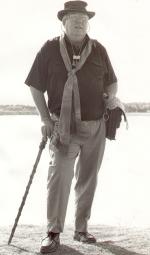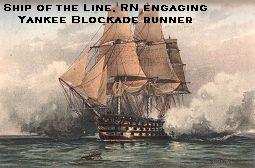 Galloping Geezer
Galloping Geezer


 Jack Downey Comments on Canadian Issues to Inform and Amuse.
Jack Downey Comments on Canadian Issues to Inform and Amuse.
Photo Credit to Julie Ann Biggs out on the Mekong River, Cambodia Vietnam Border.".
 A Play On Words
A Play On Words

<BGSOUND SRC="goldvanity.mid" >
ACT I Scene I
The British Admiralty, London, England in the year of our Lord 1795.
The Plot:
The Royal Navy allowed England to become the greatest economic power the world had ever known from the mid 1700 up to the end of the 1800s. Those were the days of "Wooden Ships and Iron Men."
The Leading Man, Dr. Rumpot:
The Navy's medical profession was in its infancy in the days of sail. On board His Majesty's Ships (H.M.S.) the medical profession was usually represented by a drunken scalawag, referred to as the ships Surgeon. The Sawbones, as he was really called, had a panacea for almost all diseases, i.e. Rum or Grog (Gin, gunpowder and water.) Damaged limbs were seldom reset and blood poisoning was almost certain, so amputation was the normal. Anesthetic was unknown so the surgeon had the man held down by his Mess mates, filled with him with rum and a lead bullet was placed in the patients mouth to bite on while both the patient and surgeon drunk, the crude amputation took place (hence the term 'bite the bullet'.)
The Botswain's Mate, Petty Officer Oliver Snarl:
The Bo's'n's Mate's cure for any slackness was a "Starter." It was. a vicious crack from a large rope's end that usually cured a Matloe (period slang for "sailor") or Royal Marine Pongo (period slang for "soldier") of any wild idea of an extra tot of rum from the Sawbones or time off their watch. Even though Snarl was blind in one eye, he saw to the running of the crew and missed few infractions., he was not to be trifled with by man or boy. (Cabin boys went to sea at age 12). Ships of the Line (Royal Navy gun ships) were very labour intensive and were often under manned. Press gangs were sent ashore to Shanghai (period slang for "kidnap") any and all men, found drinking in the water front pubs or even passing through towns near the coast, to fill the ship's constant need for more crew. When landsmen were Pressed they were usually taken unaware and clubbed down. The next thing they knew ,they were heaved into a holding pen down in the Orlop deck where they stayed until the ship had put out to sea. Then their seamanship training began in earnest, speeded up by the Bo'sn's Starter. Voyages of 2 to 4 years were not uncommon. Most pressed seamen never saw their families again and a large majority died of neglect, crude amputations or scurvy (Lack of vitamin C). Scurvy was kept at bay with a tot of lime juice per day per man, when available. This is how the word Limy came to mean an English mariner . Surprisingly, Capt. Scott et al died of the debilitating lethargy resulting from scurvy on their march back from the South Pole.
Ship's Captain, Theodore Carbuncle:
Captain Theodore Carbuncle of H.M.S. Bilgewater prepares to sail for the Newfoundland station to cut off Yankee blockade runners out of Boston and New York. In WW2 the U boats used the same tactics on allied merchant ships.
Supporting Cast:
Four Admirals, Admiral Gin, Admiral Tonic, Admiral Wine and Admiral Lummox.
The loss of any hand to work the ship was a grave concern to the Admiralty. If a man broke a limb (very common) he was just so much super cargo and a cost to his Majesty and so did not draw rations while he was not working. The daily crew meal on a warship consisted of half rotted salt meat stewed in putrid water, slopped into square wooden trenchers (plates were for Officers) and bolted down with maggot ridden ships biscuits. This is the origin of the expressions "three square meals a day" and "room and board" (the square meal was in fact served on a square board).
ACT I Scene II
Surgeon Rumpot is seen testing the rum while mixing it with water and a bit of gunpowder to give the grog some flavour. Finishing this task he stumbles back to his cabin with a very large tot of rum. He decides to write a letter to the admiralty to inform them of a new cure for broken legs that he had discovered. Two days earlier, Bo's'n's mate, Snarl had fallen off a spar while starting a slacker and had broken his leg when he landed on a hatch cover. The surgeon had attended Snarl and, two days later, he was back on the job and his leg was good as new.
A Pongo is given the sealed letter and takes it ashore to the fleet message center in Portsmouth Dockyard whence it is delivered to the admiralty in London three days later.
ACT II Scene I
Surgeon Rumpot's letter moves up the chain of command at amazing speed, landing on Admiral Lummox's desk in just over a fortnight after arriving in London. Lummox immediately calls a conference of Admirals Gin, Tonic, and Wine. Snarl's amazing medical break through was astounding to all and had to be recorded and heralded throughout the fleet immediately. Since H.M.S. Bilgewater was due to sail for Newfoundland in twenty-four days, the admirals ordered a coach to take them to Portsmouth victualing station at first light the next day. The month being February, it was cold enough to freeze the balls off a brass monkey (device to hold three cannonballs beside each gun for fast action). Cold weather caused the steel cannon balls to shrink at a greater rate then the brass monkey shran,k causing the balls to drop through the brass shot holders. Thirty-four pound steel cannon balls rolling about the deck in a rough sea would break a leg in a twinkling of a eye.
Arriving in Portsmouth, chilled to the bone, the Admirals are piped aboard H.M.S. Bilgewater at four bells and greeted by Cap'n Carbuncle, who, for a change, was sober. They all retire to the captains cabin, where several large tots of rum helped wash the frost from the trip out of the admirals gullets.
Getting down to business, Admiral Gin, demands to know what this new medical cure for broken legs is. Cap'n Carbuncle allows that he knew of no special cure discovered on his ship. Admiral Toddy responds with "Carbuncle you'd better bloody well know what's happening on this ship if you know what's good for you!" Cap'n Carbuncle swills down another very large tot of SRD (Service Rum Demerara), bangs down his empty tankard, and stands his ground. He vehemently denies that anything untoward is afoot on his ship! Admiral Wine thunders "get the bloody Sawbones Rumpot in here!" A Pongo Sgt. is sent to fetch Surgeon Rumpot.
ACT III Scene I
Enter the bleary eyed and disheveled, surgeon, stinking of rum and BO. He is seated and all the Admirals and the Captain glower at him. Everyone is a bit bewildered, so each takes another tot of SRD to settle down and get this important matter into focus. Admiral Gin demands an explanation of Rumpot's letter about a man with a broken leg who was back on duty with in two days. Rumpot reminds Cap'n Carbuncle, "you might remember Bo's'n Snarl had fallen of a spar and broken his leg a while back and it was fixed with twine and carpenter's glue and the break was covered with tar." Cap'n Carbuncle allows that this was so! Admiral Lummox jumps up, cracks his head on a beam (to this day a navel officer does not stand up when the Queen is toasted due to low ship's ceilings) and roars, "get Bo's'n's Mate Snarl in here at once!" The Pongo Sgt. rushes up to the deck and Snarl is told to report to the Captain. NOW! Snarl enters the cabin, knuckling his brow (early form of salute) to the bevy of officers and returning their stares with his one gimlet eye (Lord Nelson was also blind in one eye and had only one arm. The term turning a blind eye refers to him claiming not to see the flags ordering him to retreat at the battle of Copenhagen.).
Admiral Toddy takes over the proceedings and asks, "did you or did you not fall off a spar and break your leg?" Snarl replies, "Arr sor, dat I did but dat dare Sawbones patched it up good as new." Admiral Wine queries, "How many days were you off duty?" "Arr sor, just two days arf til duh glue and tar set" comes Snarl's reply. Admiral Gin jumps in with, "I do not believe this to be possible and I'll have your guts for gaiters if you're lying Snarl! Show us the leg!" Snarl reaches down and pulls up his pant leg to show a wooden leg patched up good as new with twine, glue and tar!
FINALE
The Admirals are being rowed ashore. Twenty minutes after their landing, the Portsmouth naval signal tower flies signal flags that read "H.M.S. Bilgewater will weigh anchor and depart for the Newfoundland station immediately.'
The Bilgewater runs up ACK (acknowledging their change in orders.) Bo's'n Snarl is seen vigorously starting all the crew aloft to set sail. Cap'n Carbuncle and the Sawbones Rumpot crack another carboy of rum and prescribe a double ration of grog for all hands when the sails are set and the anchor catted up (tied down for a long sea voyage.)
Three months later, H.M.S. Bilgewater sinks in a North Atlantic gale, while chasing a Yankee blockade runner off Sable Island. All of the several bodies recovered on the beach, including Sawbones Rumpot's, had big grins on their faces. It was almost like they had died laughing... or so it is written in the Sable Island light house Log book.
Moral of this Three Act Play:
It ain't what you do say that matters. It's what you don't say that really counts, on land or at sea.
Curtain
One may wonder what all this has to do with Canadian Culture. The answer is "actually, quite a lot:"
- Nova Scotia and New Brunswick were the source of Masts, Spars and timber for the British sailing ships.
- Halifax was a major naval repair port for British War and Merchant ships damaged at sea.. Many early Canadian shipwrights were trained along the whole of Canada's East Coast repairing British ships and cutting masts and spars for the RN. Lunnenburgh Nova Scotia is still producing wooden ships for Iron men! E.G. The famous schooner Blue Nose.
- St. John's Newfoundland had a considerable amount of British ships' stores warehoused, such as spare sails, gunpowder and shot and Barbados rum, to replenish ships sailing on the Newfoundland station.(referred to as Newfie John then and now by all mariners).
- To this day, barrels of the very best Madeira wine are stored to mellow and age for three years in some of those old rock store house caves in Newfie John.
- The terms "half shot" or "gunned up", referring to drunkenness, come from the practice of adding gun powder to the gin and water grog the mariners drank to kill the taste of putrid water on board ship. he main ingredient in modern water filters and early gunpowder is charcoal..
- The expression "It's cold enough to freeze the balls of a brass monkey" is still used by Canada's Maritimers to this day, even in mixed company.
- The word Matloe is still used to day to refer to a Canadian or British navy hand (French for Mattress.)
- Pongo still refers to a Canadian or British soldier by sailors (from Pongo Orangutan).
- SRD is still issued in the Canadian Forces (on rarer occasions now). It's military name is Service Rum Demerara. Be assured that modern Canadian navy ships have real anesthetics in their Sick Bays
- The rank of Botswain's mate is still used in the Canadian navy
- Limy is still used to refer to an Englishman.
- The British system of communicating with flags (not semaphore) is still used on formal occasions on Canadian warships and at Yacht Clubs. Mariners pride themselves in being able to ready these flags.
- The above type of story is still used to teach accurate and precise report writing and Ship's Log entry.
- Canadian War Ships are still named Her Majesty's Canadian Ship (HMCS)
- Canada has a fair share of bosses, politicians, military generals, admirals, and other dunderheads like the Admirals -Lummox- Gin-Tonic and Wine who are out of touch with the real situation.
- Newfies have a brand of rum called Screech, going back to the days of ship surgeons giving copious amounts rum to a Matloe before sawing off a limb. This anesthetic with the biting the bullet generally reduced the screeching in pain to a minimum (Lord Nelson's body was shipped back to England in a cask of rum and the crew kept purloining drinks through a hole drilled in the back of the cask!)
- Last but not least, there are people who doubt that this ever happened, but it did, only the names were change to protect the ignorant.
- The most famous Wooden Ship with Iron Men, was H.M.S. Victory.
(Virtual tour).
Sunday, September 08, 2002
J. C Downey
Send comments to: Jack
Thanks for your help
best regards
www.CanadianCulture.com

Get Involved!
Your Ideas are Important!
Content is contributed by various Canadians and does not necessarily
reflect the views of canadianculture.com.
|
 


|

